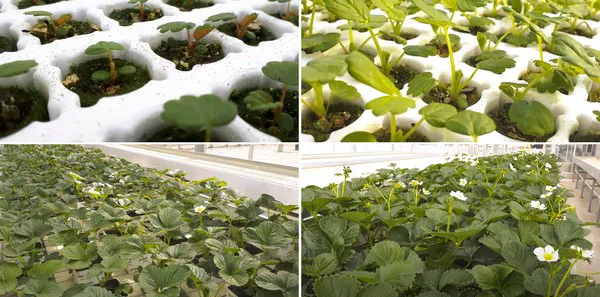The test with growing strawberry plants on rock wool at ABZ Seeds could be called a refreshing course. What is happening this spring in the greenhouses of the breeder of F1-hybrid strawberry varieties is not new. In the nineties, ABZ and a rock wool producer already performed a test which showed there were no obstacles.
Trials with strawberry cultivation on rock wool by Wageningen University & Research* and Proefcentrum Hoogstraten with breeding and/or production cultivation on rock wool and signals from the market showing renewed interest from growers were the cause to refresh knowledge and expertise.
Gé Bentvelsen, ABZ: "The most important conclusion is that it is certainly possible to grow excellent starting material without too many problems, and particularly without chemical crop protection. Rock wool is supposed to be less forgiving than natural peat or coco substrate, because small errors in feeding can have an immediate effect on the plant."
Sterile
But if breeding fruiting vegetable crops is possible, it should also be possible with strawberries, right? "Yes, exactly, that was our thought, back then in the nineties, and now as well."
With the increase of the acreage of covered strawberry cultivation (after tomato, bell pepper and cucumber, the strawberry is already number four), it is a crop which sees major investments to innovate and to become more sustainable. In a large cultivation, sustainability takes quicker effect and so the objective is a robust, renewed cultivation system in 2030, without chemical means.
Gé: "Particularly with regard to growing strawberry plants in tray fields outside, the breeding on rock wool can be profitable. Breeding in a greenhouse is less sensitive to weather conditions and rock wool is very sterile. Moreover, when breeding with cuttings, there will be lesions and when growing from seeds, there will be none."

The various growth stages, clockwise from top left, after week 4, 6, 12 and 14.
'Simple'
In the nineties, there was no interest from the industry for growing of F1 hybrid strawberry varieties from seed on rock wool, but that interest seems to be there now from growers outside the Netherlands (Gé mentions South Korea, Japan, Australia, and, closer to home, Belgium).
And perhaps in the future also in the Netherlands, Gé expects, although he does not want to anticipate too much. "We are now focusing on the breeding phase, although we keep growing the plants and are now able, after four months, to harvest the first fruit. The main goal for now was to refresh the knowledge and show how easy it is to breed F1 hybrid strawberry varieties on rock wool."
*study into both breeding and production cultivation started in a four-year project in 2018
For more information: 
ABZ Seeds
www.abz-strawberry.nl
Gé Bentvelsen
ge.bentvelsen@abz-strawberry.nl
